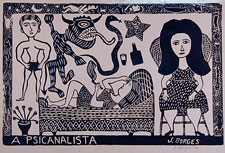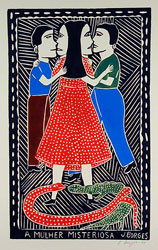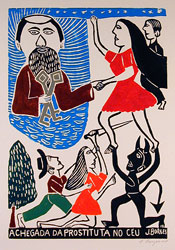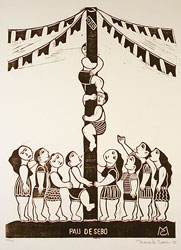Of Cordels and Woodcuts: José Francisco Borges
 I must be living under a rock, because I just discovered the work of J. Borges. I first heard of him when I saw "A Psicanalista" (left). I found the image of the two women at work both oddly erotic and curiously innocent: the slightly akimbo maternal legs of the psychologist, and the patient feverish with the efforts of unearthing the self, unloading the psyche, her hand caressing her own forehead as she conjures up a variety of crude images, which float above her. I loved the cosmic frame around them both, the starriness of the dots that made up those images, and I was taken by the grounded, fanning plant at the foot of it all.
I must be living under a rock, because I just discovered the work of J. Borges. I first heard of him when I saw "A Psicanalista" (left). I found the image of the two women at work both oddly erotic and curiously innocent: the slightly akimbo maternal legs of the psychologist, and the patient feverish with the efforts of unearthing the self, unloading the psyche, her hand caressing her own forehead as she conjures up a variety of crude images, which float above her. I loved the cosmic frame around them both, the starriness of the dots that made up those images, and I was taken by the grounded, fanning plant at the foot of it all. After seeing more of Borges's prints, I noticed the recurring themes: dreams, women ( ideal/ distorted views of), twinning selves, the Garden of Eden, snake imagery in general, and fable.
After seeing more of Borges's prints, I noticed the recurring themes: dreams, women ( ideal/ distorted views of), twinning selves, the Garden of Eden, snake imagery in general, and fable.The NYT wrote something this summer about Cordel: traditional Brazilian verse that is printed up in pamphlets with woodcuts such as Borges's on the cover. Borges himself is a Cordel bard, who dropped out of school at 12.
 Sample titles for Cordel pamphlets include "The Girl Who Beat Her Mother and Was Turned Into a Dog", "The Girl Who Married 14 Times and Continued Virgin," "The Woman Who Put the Devil in a Bottle", "The Man Who Married a Donkey," and "The Romance of the Mysterious Peacock." Needless to say, hilarious shit (see "A Prostitute's Arrival in Heaven", left).
Sample titles for Cordel pamphlets include "The Girl Who Beat Her Mother and Was Turned Into a Dog", "The Girl Who Married 14 Times and Continued Virgin," "The Woman Who Put the Devil in a Bottle", "The Man Who Married a Donkey," and "The Romance of the Mysterious Peacock." Needless to say, hilarious shit (see "A Prostitute's Arrival in Heaven", left).From the NYT piece: "Some of the most popular stories can be traced back to European legends, to Charlemagne in the 10th century, but most originated in Iberia in the late 16th and 17th centuries," said Mark Curran, a professor at Arizona State University who has written several books on cordel. "Yet the genius of these stories is that even the ones that come from the Orient have been totally adapted and recreated to suit the circumstances of the Brazilian northeast."
In addition to fiction titles, Cordel poets also write journalistic pieces, and the goverment apparently uses the form as an information vehicle to teach people about STDs and agrarian reform.

Reading the articles and seeing the art got me thinking about the flexibility of the art form and how cool it would be to collaborate with Cordel poets and woodcut artists. Sure enough, I discovered that Eduardo Galeano has written a book with Borges (Walking Words) that does just that.
I'm really interested in more experiments of this kind. I was trying to think of similar Arab popular art/lit forms, and have come up with some ideas- mostly revolving around 1,000 nights and a night-- but it's still early.

0 Comments:
Post a Comment
<< Home